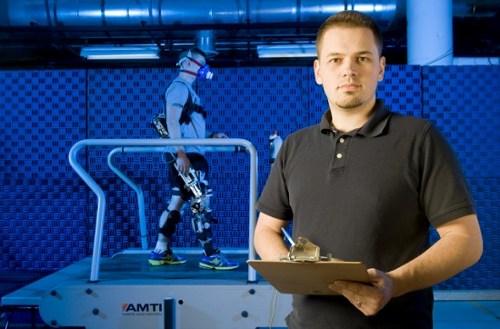 |
| May 28, 2013 | Volume 09 Issue 20 |
Designfax weekly eMagazine
Archives
Partners
Manufacturing Center
Product Spotlight
Modern Applications News
Metalworking Ideas For
Today's Job Shops
Tooling and Production
Strategies for large
metalworking plants
U.S. Army tests Yale spring-loaded knee brace
By Alexandra Foran, NSRDEC
Weight, hinge design, and assistive power of a quasi-passive exoskeleton were studied at the U.S. Army Natick Soldier Research, Development and Engineering Center (NSRDEC) in Natick, Mass., recently to see how these factors affect the way an individual walks.
The study, done in conjunction with Yale University, also measured how much energy a person used walking with the knee brace.

Al Adams, a biomechanics research engineer at Natick Soldier Research, Development and Engineering Center, Mass., has been studying the weight, hinge design, and assistive power of a quasi-passive exoskeleton. [Photo Credit: David Kamm, NSRDEC Photographer]
"The Yale engineers, under direction of Dr. Aaron Dollar, have built what can be simply defined as a pair of knee braces with springs built into them," said Al Adams, NSRDEC biomechanics research engineer.
The foundation of the Yale design is a pair of commercial off-the-shelf knee braces, comparable to the knee orthotics people use post-surgery or if they are suffering from knee pain. The major difference of the Yale design is the quasi-passive robotics -- meaning the actual mechanical work of the device is done by springs, but the springs are controlled by electric motors and computer.
Testing involved 13 Soldiers from NSRDEC's Human Research Volunteer program. The participants wore a brace on each knee, which weighed at total of 11 lb. Each brace contained a spring, an electric motor to engage/disengage the spring, and an electronic controller.
The device loads the spring at the beginning of each step, "slightly helping to extend your knee and removing some of the force usually applied by your quad muscles," Adams said. Disengagement of the spring occurs right before the leg is swung forward for the next step, "so that you do not have to fight against the spring when flexing your knee closed during the swing phase of your step."
After orientation sessions using the brace to walk normally on the ground and to walk on a treadmill, data was collected during a testing session that involved six different 10-min. walking trials. The trials included knee braces with three different springs of varying stiffness, no springs, hinges of the knee brace detached, and a trial without the braces as a control condition.
Heart rate, rate of oxygen consumption, and muscle activity were measured during data collection sessions. Motion-capture cameras were also used during the testing to record the volunteers' movements.
"Understanding the effects of each of these design aspects will help current and future exoskeleton engineers to optimize their system and reduce its negative effects on the user," Adams said.
Previous exoskeletons tested at Natick were evaluated as advanced technology prototype products, not necessarily to answer fundamental scientific questions on the effects of exoskeletons on Soldier performance. Prior testing of robotic prototypes designed to assist Soldiers with heavy combat loads resulted in Soldiers using more metabolic energy walking with a personal augmentation system than they did when they walked without an exoskeleton.
This research-specific exoskeleton designed by Yale had "built-in adjustability" for engineers to test their hypotheses. In addition to looking at how the weight of the device affects the user, NSRDEC wants to examine how the hinge design alone affects the user. One of their hypotheses is that the hinge design may be limiting motion.
According to Adams, previously tested exoskeletons assume the knee is "operating like a pin joint. Think of a hinge on a door where it just rotates in one direction. But really the knee is sort of doing that but also rotating a little bit in another direction, as well. So the multiple degrees of freedom is something that most wearable devices assume doesn't exist or isn't necessary."
For the last decade, in particular, exoskeletons have been considered as a solution for unburdening Soldiers on the battlefield and assisting with Soldier load.
Adams said he hopes that working alongside exoskeleton engineers in a series of basic research programs will help answer the question of why previous exoskeletons did not aid in Soldier load carriage.
"This knowledge will aid current and future exoskeleton developers," said Adams, "as well as inform biomechanists at NSRDEC with regard to the unique challenges of devices like these to ensure the success of future, related efforts."
Published May 2013
Rate this article
View our terms of use and privacy policy
